In the digital and dynamic world of eCommerce, it’s impossible to guess why your customers shop with you.
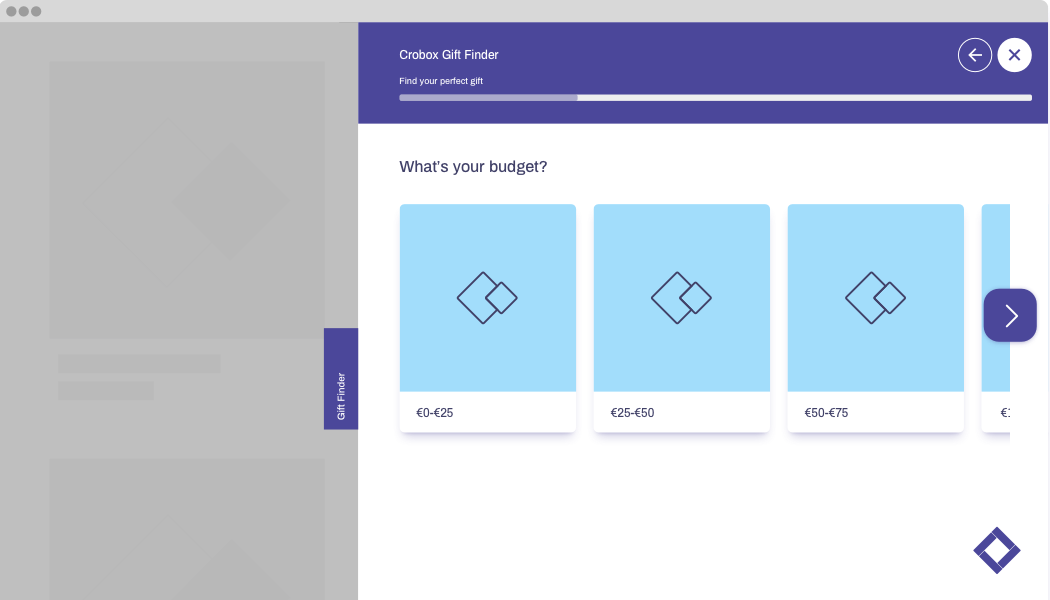
In the digital and dynamic world of eCommerce, it’s impossible to guess why your customers shop with you.
Why do they buy the products they do?
How do they find the products they’re looking for?
What products are they even looking for in the first place?
These questions can’t be solved by guesswork, which is why data is so important for your eCommerce success. But on the flip side, you’re struggling to be data-driven.
You want every decision you make to be data-backed, but you have just so much of it at your disposal. You’re not alone. Your competitors also wrestle with making data actionable.
So what do you do?
Guided selling is the tool that enables eCommerce product discovery. It’s so effective and future-proof because it works at the intersection of data and customer-centricity.
You’re not only helping your shoppers find the perfect products, but you’re also gathering intel on how they navigate your guided selling in real-time.
To tell you the truth, you can do it all: Guide, advise, and start conversations with your shoppers, while also collecting information about what products they’re looking for, how they’re finding these products, and why they’re buying them.
See the pattern?
Sure, guided selling is a sure-fire conversion driver. But its beauty lies in generating unique data based on:
Before you shout; But how???? I’m going to show you some really awesome examples. Seven, in fact.
With each of these data-driven guided selling examples, you’ll see how to personalize your eCommerce product discovery.
Before we jump in, let’s take a look at how effective guided selling is - both psychologically and for your business KPIs.

I had a chat with our in-house behavioral designer to answer this question. For your eyes online, here’s his expert advice:
“People tend to use guided selling tools if they’re unsure or hesitant about what to buy. You can help them make decisions while saying, “I’m listening to you”.
When people need to pick a product, they need help. They either look to the behavior of the group (as in Social Proof), or they look to Authority. Guided selling leverages Authority because shoppers put their trust in the retailer to find them the best product.
It’s like consulting an in-store expert - except online. So you have to make sure your customers feel heard, which is why the design of your questions need to be influenced by a sound understanding of who the customer is (psychologically), what makes them click online (their behavior).” - Patrick Oberstadt, Behavioral Designer at Crobox
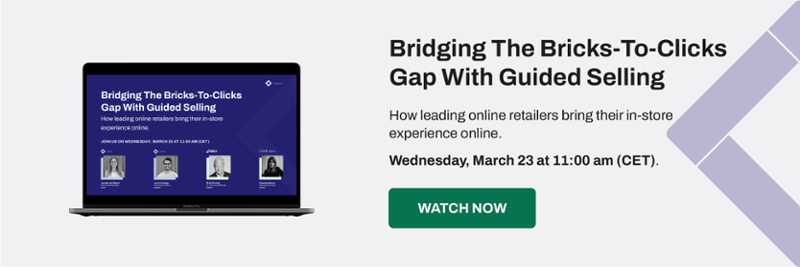
When talking about cognitive biases and what motivates a person to trust your brand, psychology is a must. Recruiting a behavioral designer (or a UXer) could really take your guided selling to the next level.
But aside from psychology, here are some quick and easy wins for your overall business goals. Guided selling:
But the most important part of guided selling is that you are actively collecting information about your customers in a data-safe way.
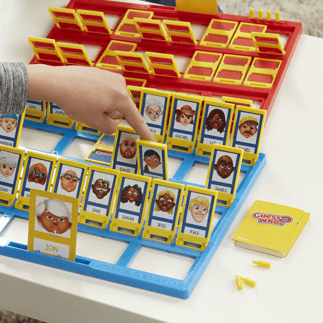
Remember the game Guess Who?
The more questions are answered, the more you narrow down who you’re talking to. Guided selling provides the behavioral data that will pave the way for moments-based personalization.
Don’t worry - I’ll explain all of this in these seven guided selling examples.
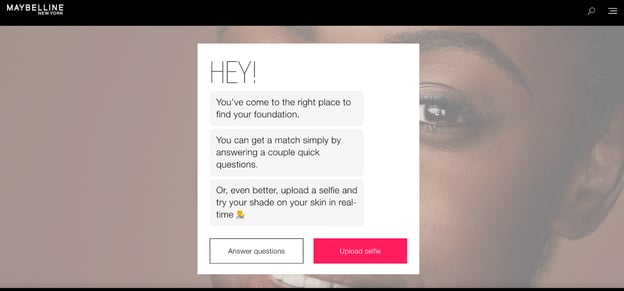
How do you emulate an in-store sales expert online?
Well maybe(lline) you simply ask? Guided selling is all about asking questions to your shoppers and then guiding them through the sales funnel based on their answers.
Maybelline’s guided selling example does this by leveraging a chatbot to springboard product discovery. A real conversation starter (literally).
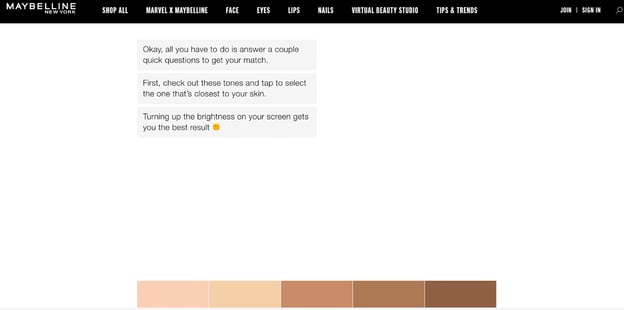
Chatbots are also a good strategy because you can tell your customers why you’re asking these questions in the first place. As a DTC brand, you can highlight your tone of voice and create that one-to-one connection the digital world often lacks.
Crobox Tip: The less text the better. Try one-sentence questions. When leveraging chatbots, make sure your copy is checked and checked again for brand tone-of-voice. Make it conversational (as if it’s a real person talking) to get rid of the resistance to automated messages.

While most shoppers use guided selling because they are goal-oriented, many will also use tools like this for inspiration.
After all, product discovery is about both finding and exploring products.
Guided selling is equally appealing for your discovery-oriented shoppers. Plus, these customers feed unique data back to you based on their answers.
For example, Anomalie helps brides-to-be find their perfect wedding dress. They ask a series of questions accompanied by different photographs of the product in use so that shoppers can pick the styles they like the most.
In the end, the webshop puts together the perfect style to match the shopper’s interests, goals, and even aspirations.
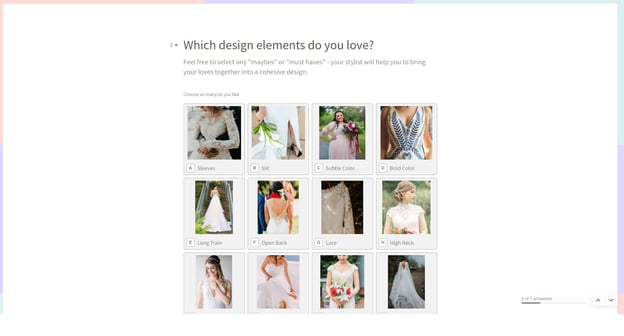
And the icing on the (wedding) cake?
The data from the guided selling choices can be used by product creation teams:
E.g, If many Anomalie customers click on the details like “long train” and “open back” together, their creative teams are learning that these are elements that resonate with their target audience. They could create similar dresses or looks based on these attributes.
Anomalie could also use this data to track trends. While “slit” and “lace” might be all the rage at one point in time, “high-neck” and “sleeves” might be the bridal must-have at another point in time.
They could also track cultural or geographical differences. This is really important information to optimize marketing campaigns in the future: Here’s data that can be made actionable all throughout the supply chain!
Crobox Tip: Give shoppers two to three options to answer your question. Especially if you’re using real photographs, it’s important customers know where to look and not create information overload.
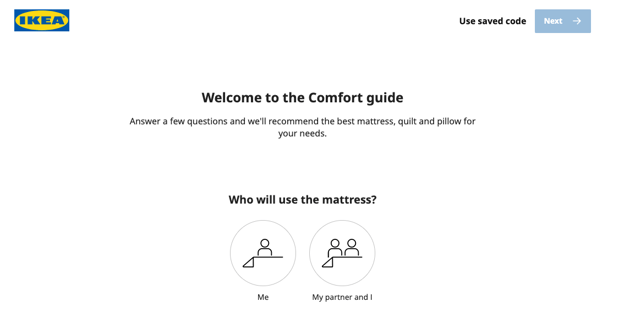
IKEA is the master of making stories around their products: They create homes from products (particularly purchases that are traditionally utilitarian).

Their “Comfort guide” recruits a similar strategy. They recommend multiple products that will help their customers set up the perfect sleep. Which is what makes it such a valuable journey for the end-customer….and, of course, IKEA.
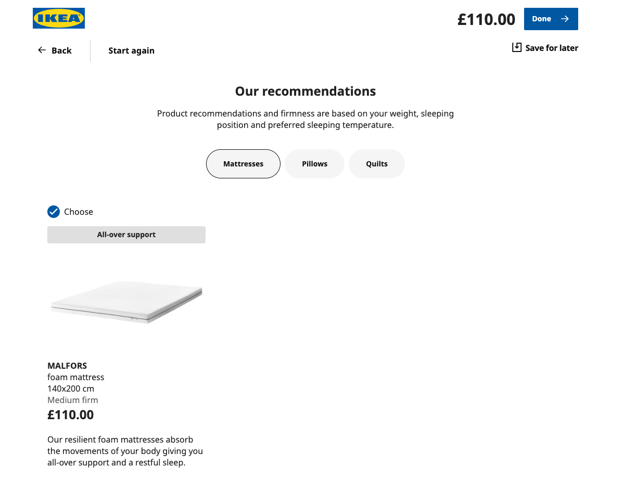
Data of this kind will also provide information to IKEA that could inform things like:
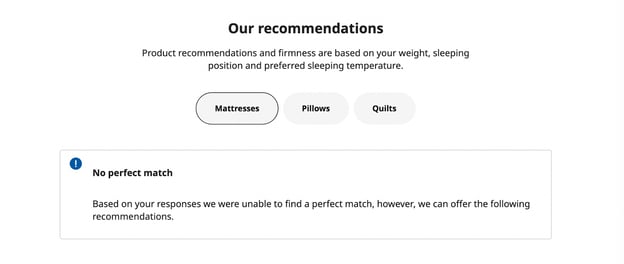
Crobox Tip: IKEA actually circumvents this problem by offering other recommendations. They aren’t “perfect”, which is a shame, but it’s still a good idea to give choices no matter what. You could also place product badges on the products that are “best match” and “good match” to show a hierarchy of recommendations.
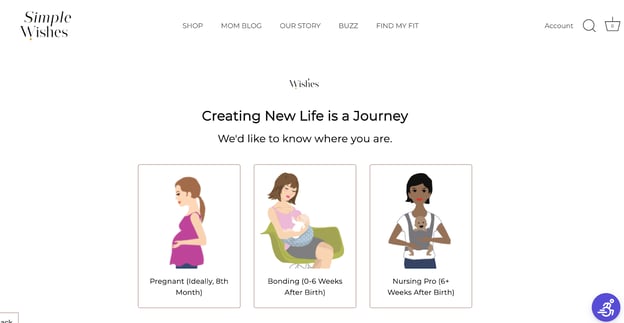
Simple Wishes guides new mums to their perfect nursing bra. While this provides proactive assistance to their audience, this kind of communication doesn’t stop at the final recommendation.
Instead, Simple Wishes can leverage the answers to analyze where moms are in their journeys, and then send them relevant educational content (as an example) to help them through their pregnancies.
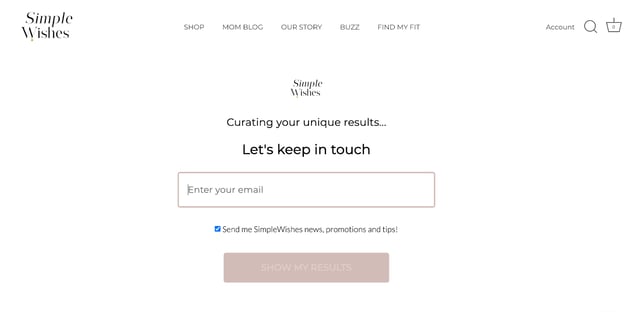
Crobox Tip: Collecting emails is great, but users need to have a reason to give it to you. After all, this is private information. Instead, give your customers their results straight away, and ask for an email to a) download and share the result, or b) read more information about the product.
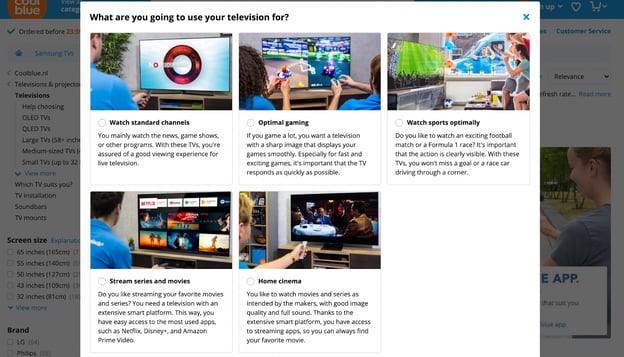
Coolblue mostly sell electronics, so having a guided selling tool (for technical products):
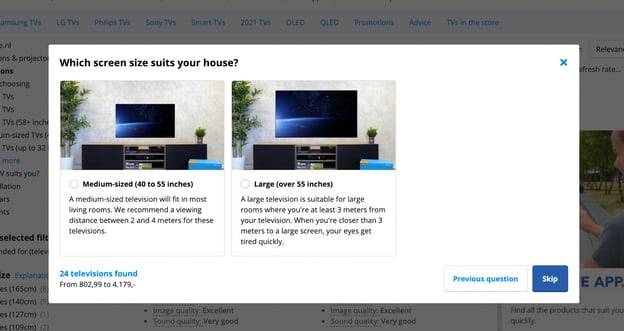
What’s excellent about this is that Coolblue have done their research. For instance, when looking for a TV to buy, the first question they ask is, “What are you going to use the television for?” with options ranging from gaming to streaming. The user can choose multiple options to refine their search.
Crobox Tip: Guided selling is about making your customer journeys fluent, streamlined, and delightful. Once again, text-heavy descriptions will cause a mental barrier to these three things. Instead, leverage info-bubbles with information if someone hovers over it. Or, bullet points with the main parts to make the copy scannable.
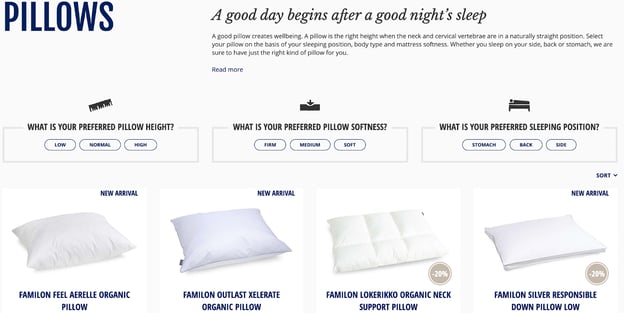
Familon hasn’t built a fancy guided selling tool. Instead, they’ve strengthened their filtering foundation. A great workaround if you don’t have the IT capacity or resources to build a guided selling tool - like a product finder - from scratch.
Customers can choose three options: Pillow height, softness, and sleeping position. The webshop then filters the results to recommend the perfect pillow for that customer.
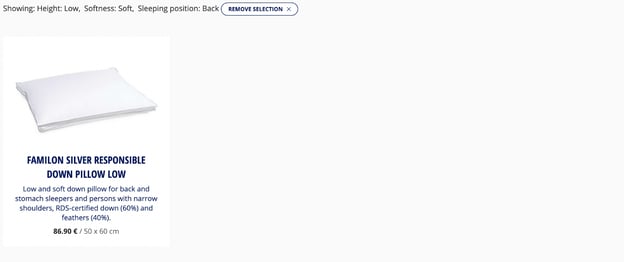
Guiding shoppers by letting them filter on attributes is valuable because you’ll understand more about how your product characteristics can lead to benefits. Which is data that can inform your product messaging and communication.
E.g., A shopper who filters on low pillow height, soft, and sleeps on their back may be searching for a new pillow because of neck pain. This information is an assumption backed by data, but one that your market research and segmentation should also support.
But Familon’s tool is still a beta version of a guided selling tool.
Crobox Tip: The point of guided selling is to personalize the customer journey. Throughout guided selling, you are reducing barriers by filtering for the customer. If shoppers have to do this themselves, this could cause journey resistance and bounce.
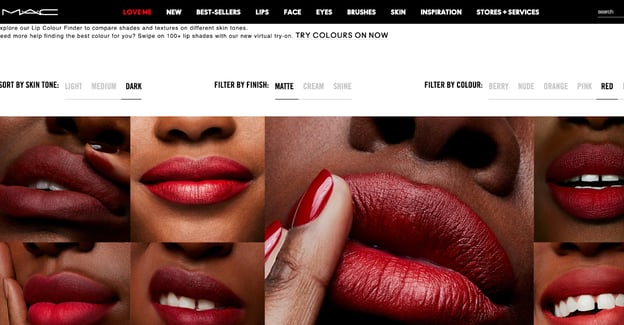
See Mac’s Lipstick Finder for how filtering is used to inform the guided selling journey.

ASICS’ Shoe Finder was built to emulate an in-store assistant. The quiz wizard asks questions to determine the shopper’s running style, goals, and profile. The final answer is revealed and its attributes showcased so that shoppers have a shoe profile that fits them.
Sleek, right?
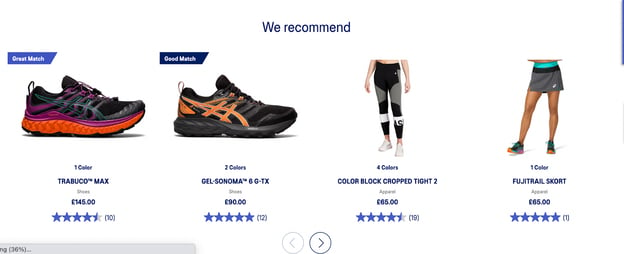
At Crobox, we also elevated ASICS’ guided selling by having product badges on the recommendations (based on Great and Good match). So when you click on the product it takes you to the PLP, but the product discovery is further personalized with badges.
Crobox Tip: If you’re selling technical products, a product comparison will take your guided selling to the next level. This isn’t something that ASICS could implement on their results page to show attribute comparisons like pronation, price, comfort, etc.
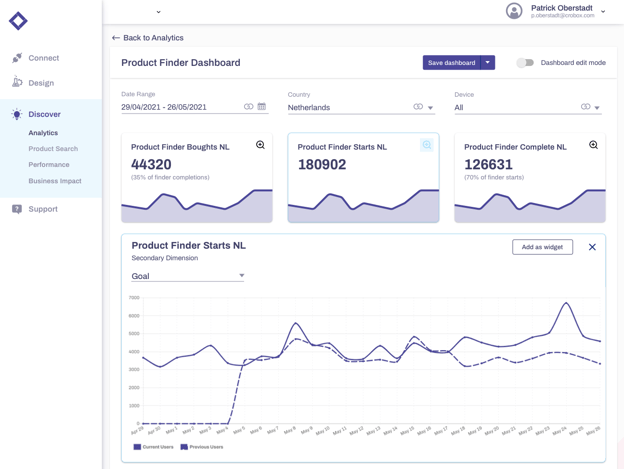
To take your guided selling to the next level, Crobox offers a dashboard where you can visualize your data in the best way.
Half of the work of your guided selling is in the design, but the other half rests in analyzing the data you get.
There’s a lot of data you can check, from flow data (how people navigate the guided selling tool) to click-data (what products or answers people are actually clicking on).
So how do you visualize it?
Well, you need a couple of things to get started:
Start with guided selling today and you’ll witness a win-win for both the customer (who discovers their perfect products) and your organization (with higher business impact).
These guided selling examples are all leveraged by brands that listen to their customers and personalize their products and journeys based on what they’ve learned.
This approach will not only skyrocket your product sales. It will help your customers in their decision-making, creating delightful behaviors throughout their overall product discovery journeys.